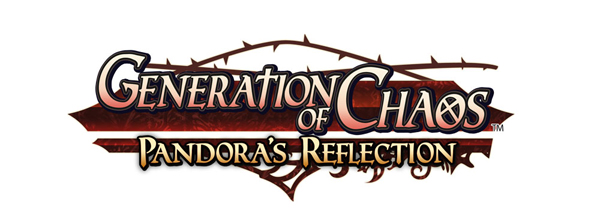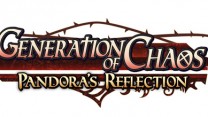 The latest game in Idea Factory’s strategy series, Generation of Chaos: Pandora’s Reflection is a departure from its normal fare. They’ve teamed up with Sting, best known for their Dept. Heaven games, to breathe new life into the series. And with notches like Yggdra Union and Riviera: The Promised Land on their belt, it’s safe to say this is a favorable pairing on paper. But I think that’s enough of the name-dropping.
The latest game in Idea Factory’s strategy series, Generation of Chaos: Pandora’s Reflection is a departure from its normal fare. They’ve teamed up with Sting, best known for their Dept. Heaven games, to breathe new life into the series. And with notches like Yggdra Union and Riviera: The Promised Land on their belt, it’s safe to say this is a favorable pairing on paper. But I think that’s enough of the name-dropping.
As someone who’s been grievously underwhelmed by most Japanese role-playing games of late, I’ve realistically lowered expectations. Even series that have been reliably engaging have managed to stumble. So it is with trepidation that I approach the latest Generation of Chaos title. I don’t publish outright bad reviews if I can help it; I don’t profit by bashing video games. Onward then.
 There are two crucial elements to a good story: plot and characters. While it’s regularly debated—and rarely agreed upon—which of the two is the most important, they’re both integral. I’d say it’s a symbiotic relationship, an obligate one at that. Now, Pandora’s Reflection isn’t going to win any awards for either, but you don’t need the clout of a pompous indie title to get your point across. PR does that well enough.
There are two crucial elements to a good story: plot and characters. While it’s regularly debated—and rarely agreed upon—which of the two is the most important, they’re both integral. I’d say it’s a symbiotic relationship, an obligate one at that. Now, Pandora’s Reflection isn’t going to win any awards for either, but you don’t need the clout of a pompous indie title to get your point across. PR does that well enough.
As a skilled alchemist, your motivation is to cure your sister of her sickness. A simple enough drive, that: love for a sibling. I suppose it’d be safe to stop there, but Pandora’s Reflection has the courtesy to layer its narrative. Eventually, you find yourself challenging the oppressors of your world, which is very much dystopian. This is not something I can discuss in detail without spoiling the story—which turns out to be pleasantly dark; that considered the game does a good job of keeping you engaged. It’s no Nier or Suikoden by any stretch; yet it doesn’t suffer the same pitfalls of other recent games. Most notably: blandness. I did find the tale rather predictable and basic despite its layers, but predictable and basic are not indicative of offal.
The protagonists all had their reasons for joining in the fight explained, though most were almost insultingly brief. The mermaid wants to save her kind from the ashen rain polluting their habitat. The rebel seeks revenge. Some just don’t take kindly to oppression. Only Claude, the main character, and his sister, Yuri, really stand out. Whether that’s because of their persistent presence in the story is something I’m still mulling over. Nonetheless, the characters aren’t insufferably bad by any stretch. And that’s not something I can say for other recent titles like, say, Tales of Graces ƒ.
 If you’re wondering how exactly a game co-developed by Sting and Idea Factory would work, well, it’s somewhere between RPG and real-time strategy. Battles generally begin with you controlling your base, which is used to bring more units into the fray, and start with the player at a disadvantage. You’re charged with capturing strategy points along the map in order to marshal more of your own forces, prevent the enemy from doing the same, or control siege weaponry ranging from laser cannons to trebuchets. Personally, I prefer the laser cannons.
If you’re wondering how exactly a game co-developed by Sting and Idea Factory would work, well, it’s somewhere between RPG and real-time strategy. Battles generally begin with you controlling your base, which is used to bring more units into the fray, and start with the player at a disadvantage. You’re charged with capturing strategy points along the map in order to marshal more of your own forces, prevent the enemy from doing the same, or control siege weaponry ranging from laser cannons to trebuchets. Personally, I prefer the laser cannons.
It should be noted here with a twitch in my eye that capturing points can be a wishy-washy process. Sometimes you’ll have to wiggle your characters around for it to recognize that they’re standing on the friggin’ things. This quickly grows tiresome and really works against you given that the real-time battles can get quite hectic at times; it really is more than a just a niggle. Fortunately, the rest of the game makes up for that vexing hiccup. While the game’s mechanics eventually become second-nature, there’s a lot to keep track off. Certain classes move faster on certain tiles; certain tiles inflict damage over time; certain tiles are affected by your skills. Some classes will even change tiles after walking over them in order to make a route for those bringing up the rear.
 So you’ve got all these units running around the map, despoiling villages and generally wreaking havoc. It’s only a matter of time until they bump heads. At that point you’re taken to a combat screen. Basic stuff, here: rock-paper-scissors weaponry. The best part is that the game tells you what is good against what, so you aren’t forced to memorize these things. When it’s your turn to attack, a zippity strike bar fills. As it does, you press a quick succession of the ‘x’ button to amplify the power of your strike. Both combatants will then do damage regardless of the choice, but the fighter with the disadvantage will be pushed across the field after combat has ended. This is when the ring system comes into play. After combat, a ring will expand around your enemy; different weapons produce different size rings. If an ally is in range of the ring, they can perform a follow-up attack without the chance of being hit. This will continue until you either have no one else to use, choose not to, or have attacked with all your party members. It’s easily the most essential part of the game and the only way you can expect to beat most bosses.
So you’ve got all these units running around the map, despoiling villages and generally wreaking havoc. It’s only a matter of time until they bump heads. At that point you’re taken to a combat screen. Basic stuff, here: rock-paper-scissors weaponry. The best part is that the game tells you what is good against what, so you aren’t forced to memorize these things. When it’s your turn to attack, a zippity strike bar fills. As it does, you press a quick succession of the ‘x’ button to amplify the power of your strike. Both combatants will then do damage regardless of the choice, but the fighter with the disadvantage will be pushed across the field after combat has ended. This is when the ring system comes into play. After combat, a ring will expand around your enemy; different weapons produce different size rings. If an ally is in range of the ring, they can perform a follow-up attack without the chance of being hit. This will continue until you either have no one else to use, choose not to, or have attacked with all your party members. It’s easily the most essential part of the game and the only way you can expect to beat most bosses.
Generations of Chaos: Pandora’s Reflection is a solid experience that I’d recommend to anyone with a penchant for Japanese role-playing games who doesn’t mind a bit of strategy. Don’t expect it to win any awards, but it’s well worth the cost of admission: currently $20.
